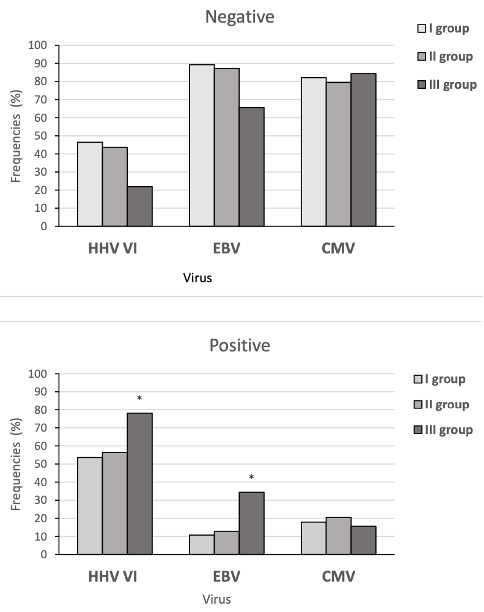The presence of HHV-6 and EBV DNA in nasal secretions correlates with the degree of adenoid hypertrophy in children
HHV-6, EBV and CMV can be found in the resected adenoids (and tonsils) of children with enlargement (hypertrophy) of these lymphoid organs. Do these viruses cause the enlargement of these organs? And might the immune response to these viruses affect the enlargement of these organs?
Russian investigators compared viral DNA in nasopharyngeal secretions in children with very enlarged adenoids to viral DNA in children with only mildly enlarged adenoids, a study involving 104 patients. Viral DNA for HHV-6, EBV and CMV was present in 56%, 15% and 15%, respectively. DNA for HHV-7 was not evaluated, nor was a distinction made between HHV-6A and HHV-6B. HHV-6 and EBV were detected more often in children with greatly enlarged adenoids than in those with only mildly enlarged adenoids; no difference was seen for CMV.

HHV-6 and EBV presence in nasopharyngeal fluid was found to correlate with the degree of adenoid hypertrophy but was negatively correlated with adenoid size in the negative controls. Group I patients had limited hypertrophy while Group III patients had maximum hypertrophy causing nasal airway obstruction.
Previous studies have reported that IL-10 polymorphisms may offer resistance to herpesvirus infections (Yaghobi 2018) and that susceptibility to herpes zoster may be inherited (Haanpaa 2002). Also, increased levels of IL-10 have been found in children with enlarged adenoids and chronic tonsillitis. Because of these findings, the investigators assessed whether the genotype for IL-10 (a highly polymorphic gene) might correlate with the size of the adenoidal enlargement—i.e., whether this aspect of the immune response might influence the enlargement of adenoids.
Russian investigators found that in the children with the smallest adenoids there was a higher frequency of the G allele and the GG genotype for IL-10 rs1800896, indicating that this genotype might protect against severe adenoid hypertrophy.
Read the full text: Lomaeva 2022

